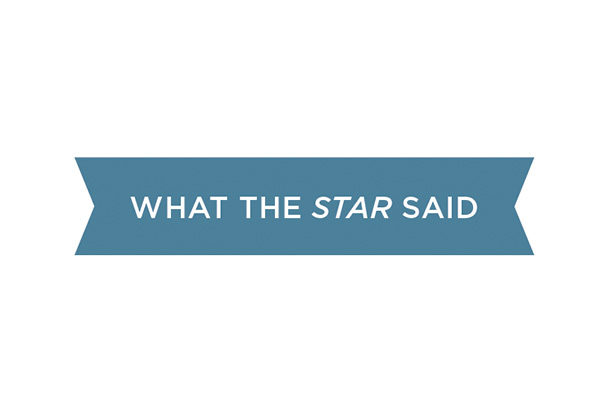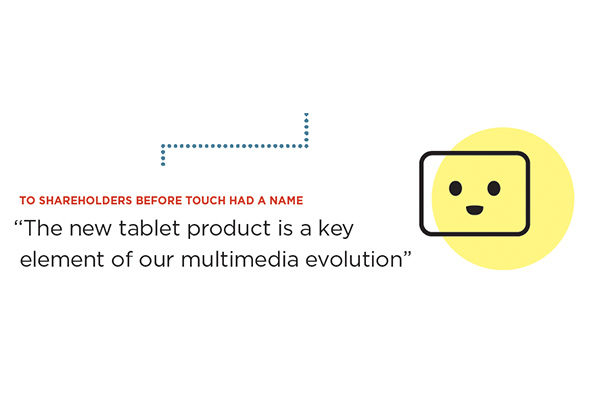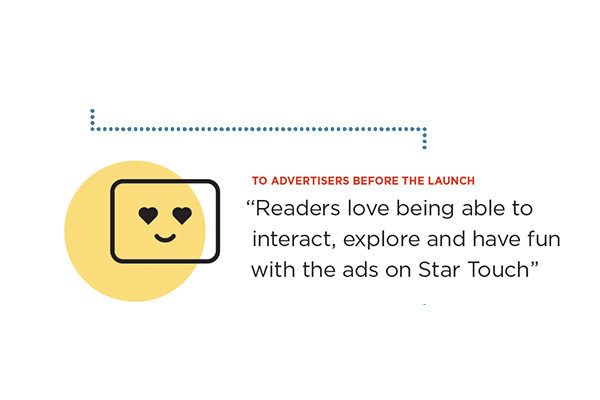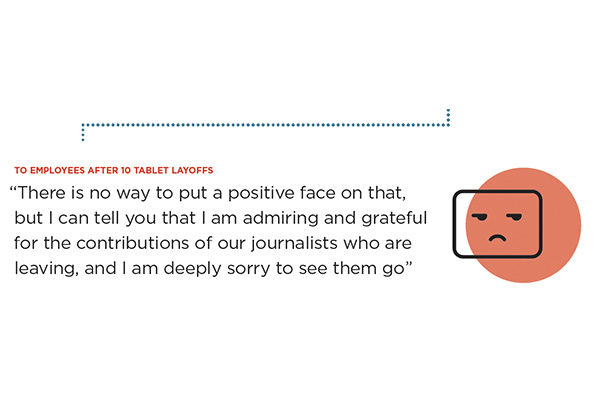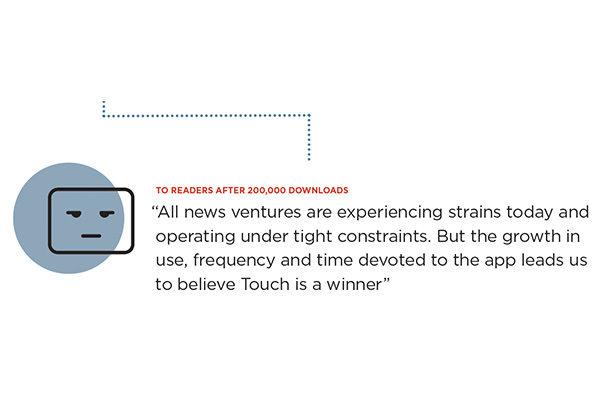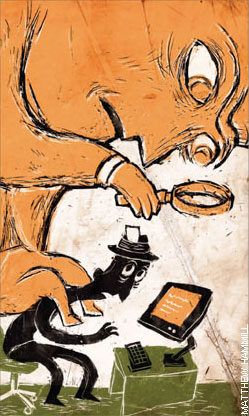Out of Touch
The Toronto Star is delivering the newspaper on tablet, but its audience may be on a different screen
Turn on your newspaper—and be prepared for a surprise. According to a November 2015 Toronto Star article by publisher John Cruickshank, the Star Touch tablet app is “the most dynamic, immersive and interactive approach to screen-based storytelling in the English-speaking world.”
But just what does that mean? Say a story on a recent Toronto Blue Jays win catches your eye: tap on the glass of your screen, and it appears before you, as if by magic. No more page numbers; no more flipping pulp like a chump. And unlike flimsy newsprint, your Android or iOS tablet is bright and, yes, dynamic. The article you select might even have a video with sources telling you their stories in their own words. This is the newspaper of today and tomorrow, if the Star has its way.
After 124 years in the business of print, the Star has finally shifted its focus to be screen-first. Its new flagship product, Star Touch, hit the App Store on September 15, 2015, followed by an Android edition at the end of November. Earlier that month, Cruickshank assembled the newsroom to announce the iPad edition had reached 100,000 downloads. In a radio interview, editor Michael Cooke said the Star is “doing for newspapers what Cirque du Soleil did for the circus.” With more than $14 million invested before the app even launched—in software, new hires, training for existing employees, market research—hype is inevitable.
“We are entering a period of fabulous life-changing non-stop revolution,” Cooke wrote in a January 2015 memo, promising the tablet app would be “successful both journalistically and financially.” The newsroom at 1 Yonge Street does look much different than it did a year ago, but the target of Cooke’s rampant adjectivalism isn’t so different from what his organization has been turning out for over a century. It might be made using technology from La Presse, rather than on a printing press, but Star Touch is a lot like a newspaper. And the Star’s newstablet may not be different enough from its print product to provoke the financial and cultural changes Cooke promised his employees.
Star Touch might be the most immersive, revolutionary circus in the English-speaking world, but that doesn’t mean the Star has completely abandoned its roots. “We maintain our commitment to print, because it’s got a strong base,” says Ali Rahnema, who was the product lead for Star Touch from the idea’s inception in early 2014 until November 2015. But print will continue its decline, he says, and the newsroom’s focus has changed to respond to that financial shift. Print will no longer be the default medium for reporters and editors. Reporters now write with the tablet in mind, which means approaching stories on the app’s terms.
Perhaps the biggest departure from tradition is the layout of stories. Take a feature from last December, when Star Touch revisited readers’ 2014 proposals for improving Toronto. The story uses the “dossier,” one of the seven storytelling methods that both Star Touch and La Presse+ apps rely on. It starts with a splash page, a magazine-style opening screen that illustrates the three ideas discussed on day one of the week-long feature. There’s a headline and a subhead, but no other text: a total of 31 words, not counting the navigation tabs along the top.
Tapping the next tab reveals a scrollable column of text, a photograph and a grade for the city’s progress on the idea. Access to affordable daycare earned a “B,” for example. Beside the grade is a grey-and-white dot, a pop-up for more information. The third tab’s layout is a mirror image of the second, but with a gallery in place of the static photo.
The app’s seven storytelling methods—single screen, dossier, vertical dossier, pop-up, gallery, anchored scroll and clothesline— give journalists the tools to report in ways that take advantage of the digital format. But their combined effect is patchy: there’s no way to get a comprehensive visual sense of how to read a story and, unlike many digital reading experiences, no indication of how long a piece might take to read. To parse a whole issue, readers navigate a bewildering array of videos, galleries, maps and scrollable text elements. But if they manage that, they can go deep on a story. For patient readers, the Star claims the app contains about 15 percent more content than the newspaper.
Unlike many touch screen products, the number of ways to manipulate the tablet edition is limited. You can scroll, swipe and tap, but you can’t zoom in, which would be an improvement over paper. Instead, to isolate a storytelling element, you use finger and thumb in a pinch-and-flick motion that causes it to pop out. In the case of a text column, it fills the screen in a jarringly contextless window. Star Touch is brightly coloured and image-heavy, but not all images necessarily add to the stories. Some of the markers of print are missing, too. A byline, for instance, often appears with just “Star Touch” under the name. It is not immediately clear whether the writer is, say, a movie critic or an education reporter.
Although the app is free to anyone with a tablet that supports the software, the failure or success of Star Touch depends on gaining enough users to attract the advertisers that the platform needs to fund its operation. Before the current version came out in January, 1,424 people had reviewed Touch in Apple’s App Store. “Too slick for its own good,” reads a one-star review (there were 117 of those), but over 1,000 reviewers gave it five stars. Over in the Google Play store, 114 reviewers gave it an average rating of 3.8 out of 5. Main complaints? Tough to navigate and not enough content.
It’s hard to replicate the simplicity of print in a digital form,” says Roger Fidler, a renowned expert in tablet innovation. Speaking over Skype from his Missouri home, the recently retired news designer says the tablet is a natural successor to print. But he doesn’t think Star Touch or La Presse+ have succeeded as the pulp-killing “portable, flat-screen display” he first imagined in 1981 as the future of newspapers.
Fidler’s more-developed 1994 idea of what a tablet would look like formed part of Samsung’s defence in 2011, when Apple unsuccessfully sued the company for alleged patent infringement related to the iPad. The 2010 iPad launch made legacy news organizations take notice. A tablet news app is aesthetically satisfying and more attractive to advertising than the open web.
But such apps have fared poorly in English-speaking Canada. Postmedia’s “four-platform strategy,” intended to bring news to its audience on different devices throughout the day, launched in May 2014 at the Ottawa Citizen. The evening newsmagazine that formed the integral tablet part of the strategy lasted only until October 2015. The Globe and Mail shied away from the La Presse tablet-first model, instead rolling out a suite of tablet and phone apps as part of a broader digital strategy reliant on multiple platforms. It also didn’t try the evening newsmagazine that failed for Postmedia.
Brian Gorman, author of Crash to Paywall: Canadian Newspapers and the Great Disruption, thinks he knows what the missing piece was for tablet editions like Postmedia’s. He imagines that people can’t see themselves represented in tablet editions. Interaction between the audience and the publication is something that hasn’t been mastered yet. If tablet editions can’t bring their print and web readers along with them, they’re no good to news organizations, because advertisers go where the audience is, and the revenue goes with them.
After launching its tablet app in 2013, La Presse had the success that has eluded English-language Canadian news organizations. It seemed to find the silver bullet that others had been seeking: a $40-million investment led to the launch of an app that succeeded both financially and demographically, leading to a growing, younger readership and a digital platform that actually pays for newsroom staff. Star Touch is another milestone for the Quebec paper: licencing its software to an English-language news outlet. La Presse intends to continue marketing its software to other newsrooms. The Star did market research through the same firm as the Montreal company, but the potential audience La Presse+ caters to is different from the Star’s—it’s isolated by language, for one.
La Presse’s transformation from print product to tech company hasn’t been without internal friction, though. La Presse laid off 158 people last September. Publisher Guy Crevier told employees that 100 of those were directly related to the decision to stop printing weekday editions.
And ample evidence shows that English-speaking adults are moving away from tablets. ComScore’s 2015 mobile app report notes that in the U.S., smartphones “account for the vast majority of total mobile and mobile app time spent.” Mario García, an American newspaper and magazine designer who worked on the Citizen for iPad, now believes the immediacy of smartphones trumps the interactivity of tablets. In an October 2015 blog post for Poynter, he argued that tablet editions are “not for every market.” They need to include a mix of news and features that are also accessible on a smartphone.
Listen: Editor Kat Eschner and senior editor Viviane Fairbank discuss the intricacies of writing about technology
For a newspaper that prides itself on getting the story first, it’s strange that Cooke declared 2015—five years after the iPad debuted—the “year of the tablet.” With Star Touch, the Star hopes to bring many of its print readers to tablet—in 2014, it had an average weekday circulation of 134,266—while attracting younger readers who never formed a daily print-reading habit. More than that, Star Touch was about deliberately choosing a digital strategy for the news organization. Cooke declined to speak with the Review. Rahnema became the Star’s chief operating officer for digital in July 2014 and drove the tablet project along with Cooke and Cruickshank. About a month after Star Touch premiered, Rahnema said it would take 18 months to know for sure if it would be a success. He maintained that the tablet edition is really about encouraging reporters and editors to adopt a screen-first mentality. “The payoff of that,” he said, “is beyond the revenue this project will generate.”
If you’re wondering why many years of website ownership hasn’t disposed the Star to think about screens first, you aren’t alone. Former reporter Joel Eastwood tweeted a critique of Star Touch last October. The future of journalism, he declared, lies in “delivering accurate news wherever it happens, to whatever device the reader wants it on.” Before accepting a job at The Wall Street Journal, Eastwood was part of the Star’s “data viz” team, one example of the paper investing in its website. The designers built interactive maps and graphics and special websites to host big projects like Michelle Shephard’s interview with Omar Khadr in May 2015. As Eastwood noted with some pride, the web components he and his colleagues designed could be viewed on “every possible device you could display things on.”
Except Star Touch isn’t web-based. Its stories don’t change throughout the day, much like a traditional newspaper. Breaking news stories aren’t fully integrated into the app, but can be read on a pull-out tab, as long as you have web access.
The Star has put vast resources into the platform. With such a strong focus placed on the tablet, web clearly isn’t a priority. The paper’s site hasn’t managed to gain a new audience, but the Star has never given the site the resources it gave to the tablet app. Management took down the website’s paywall in April 2015 when new, younger subscribers didn’t bite. With Star Touch, the Star is choosing to focus on screen-based storytelling geared for a product that more strongly parallels its traditional strength—print news— than it does the web. Eastwood believes this is a lost opportunity.
But Rahnema thinks the payoff of a digital product that can bring in big money is worth the risk of committing to Star Touch. That’s over the potential rewards of focusing on a more flexible platform like the web. Where print’s ad dollars turn into dimes on the desktop, he says, “we’re now trading those dimes for pennies, or maybe nickels, going into the smartphone.” Star Touch is an attempt to reverse that trend. The Star hopes its ads will produce results like La Presse+, which is funded entirely by advertising.
Rahnema also maintains the experience reporters gain with Star Touch will prepare them to “build a bridge to whatever’s next” as part of a longer-term digital transition. But it’s hard to say if a product that is so similar to print in terms of its static content can do enough to make its newsroom screen-first.
Star Touch could have looked a lot different, and happened a lot sooner, if a newsroom project from six years ago had been approved. A committee including reporter-photographer Jim Rankin tried to create a response to the iPad. What they developed shared many traits with La Presse+, says Rankin, currently assigned to the features team. Kate Collins, who was the project head but no longer works for the company, says that “it was a fairly extensive effort with over a year of work,” referring to the five- to 10-person team who worked on the project. Collins describes a process that initially spanned Torstar properties and became a Star-specific idea with storytelling models that exploited the tablet’s difference from print. At its heart, that version was meant to be a newsmagazine, like Star Touch.
The committee named it the Star Bulldog, an old newspaper term for an early edition. But the idea never made it off the newsroom floor—too expensive and too risky, according to Rankin. He thinks the paper probably made the right decision. But it was a significant investment of time and money for something that never happened, further illustrating the Star’s allergic reaction to digital innovation.
Five years later, Rankin and his colleagues are now coming to terms with the Star Bulldog 2.0. Or, more accurately, L’Étoile Bouledogue 2.0. Putting La Presse+ side by side with Star Touch demonstrates how they’re nearly identical, language aside. The Star’s approach to adopting La Presse’s software was to follow the French-language company’s workflow closely. But those conventions haven’t all sat well at the Star, and its pursuit of a good way to use Star Touch has left the newsroom playing Whack-A-Mole.
Traditionally, information in one storytelling element shouldn’t be duplicated in others. That standard has proved challenging for the Star. It means that a story contained in a video shouldn’t be mentioned anywhere in the text, but it’s a rule the newsroom is learning how to break.
A related convention the Star struggled with at the start was “one-touch editing.” That’s the practice of editing a story one time for all platforms, prioritizing the needs of the tablet. Star Touch favours text in short chunks and visual elements, including photo galleries, short videos and pop-up explainers. Other platforms can’t accommodate all of those elements. If it sounds like readers in print and online might have been missing something, that’s because it’s possible they were.
The Star team has begun re-editing some pieces for print and web. It’s a lot of work for journalists and editors. For instance, last September, the investigative team “player-coach” Kevin Donovan and reporters Jayme Poisson and Jesse McLean ignored La Presse’s norm by writing and editing separate versions of “Breaking Badge,” the first investigative series to debut on tablet. Speaking in October, Donovan said they weren’t going to try to do that again: too complicated and too many opportunities to introduce errors.
These conventions make sense for La Presse, since it wanted all of its readers to adopt the tablet edition. But the Star maintains a commitment to its print product, and these La Presse conventions may not allow enough flexibility to report well on both mediums, according to one Canadian newsroom leader. He says if the Star was smart, it would commit fully to Star Touch and devote resources to funnelling its print readers into the product. He is skeptical that the organization has the resources to continue working indefinitely on so many platforms.
And despite the millions of dollars that the Star spent on storytelling devices, when Star Touch launched, one thing you couldn’t do was tell a simple narrative. Rankin says the paper has now developed “simple screens” that have a picture as a background with straight text on top. Like everything else in the app, getting through these stories requires a lot of scrolling.
Some long stories, including the investigative team’s series on police misconduct, lend themselves well to the Star Touch treatment. After all, it’s easier to tell a long story with many different elements in small pieces, including text, images and case histories. And Donovan says his team was able to fit in more examples of crooked cops: eight on Star Touch, instead of a maximum of four in print.
Still, Donovan acknowledges, the story contains images that don’t relate directly to the specific officers in the story. Less than a month after the launch, he said he was spending a lot of time negotiating with designers and planning the story in its design phase. That’s gotten easier over time.
When it started working on Star Touch, the Star hired 70-odd new employees. They share the fifth-floor newsroom with existing staff. Although their number has dropped, the largely youthful tablet hires work in a dedicated area, separated from reception by a glass wall. The designers face the low cubicles where traditional reporters toil, but their embankment of shiny iMacs is conceptual worlds away.
The labour practices that brought those new people onto the payroll are also a departure from traditional methods. The details of these new contracts were negotiated with the union in 2014 following friction between management and Unifor Local 87-M. Back then, the newspaper was looking to hire eight digital journalists, with the intent of paying them wages lower than entry-level Star journalists.
The union negotiated those and subsequent hires for the tablet at a lower rate. Local 87-M understood that the company was making a bet on Star Touch that could benefit its members. But when the contracts end this December, the union hopes to negotiate permanent positions for the new people that the paper wants to keep.
In an unpopular memo, Cooke and managing editor Jane Davenport informed the newsroom that the lower rate was competitive with the pay for similar positions at Rogers, The Huffington Post or Facebook. “Personally, I thought that was not a great comparison,” says Rankin, who is also one of five union stewards, “because at the Toronto Star, we compare ourselves to The New York Times or The Globe and Mail or CBC.”
“Our journalists are craftspeople,” says Liz Marzari, former unit chair for the Star local. She still works at Unifor but previously worked in the paper’s ad department, which disappeared when the Star moved its advertising to Metroland. The Star Touch hires deserve the same respect as cub reporters, she says, even though their role is new. The company and the union are both hoping more people can become permanent without incident. But if Star Touch doesn’t do as well as hoped, some or all of those people could lose their jobs, as 10 contract employees working on the tablet did in January.
Published each day at 5:30 a.m., Star Touch offers a curated selection of stories. Each edition takes a whole day to produce, in part because the process mimics print: journalists feed information to designers, and the whole thing is packaged and shipped to the consumer via tablet. It’s a process that brings comfort to anyone who thinks about news in column inches, but it represents a different kind of risk. If tablet storytelling is a dead end, the Star will be a few years behind other legacy news organizations in digital development. Meanwhile, the outlets the Star considers its competition are taking a more elastic approach to going digital. In the tech world, failure is not only tolerated, but encouraged. The goal is to experiment, build, measure, test and learn.
That’s how La Presse created its soft are in the first place: behaving like a start-up. It talked to readers and changed the app based on their feedback. What La Presse created was both a marketable software product and a tablet newspaper that has been successful where others have failed.
While still working out the digital kinks, the Star has mastered one tried-and-true start-up tactic: bluster and hyperbole. Most dynamic. Transforming the circus. Fabulous revolution. The best storyteller on planet Earth.
The Star better hope it masters the other skills of successful start-ups soon. Because, whatever is next, what it has right now doesn’t solve its problems.
Epilogue: No Silver Bullet
When I started working on this story, Star Touch was still an idea, at least outside the Toronto Star’s offices. The advertisements full of multi-coloured arrows that seemingly papered the Toronto transit system after September 15 had not yet appeared.
Star Touch’s advertising has changed since then. And two of this story’s central characters from the Star—Ali Rahnema and, soon, John Cruickshank—have left or have announced they are leaving. When Rahnema left, he told me over Facebook that his parting from the Star was “very amicable … based on strategic differences.” He didn’t elaborate, and I didn’t press. When Cruickshank announced that he was leaving, he told Canadian Press that the Star’s next publisher needed to be “a digital native,” describing himself as “a digital visitor.”
Cruickshank’s news broke on the Star’s website on March 16, the day before we received print issues of our magazine at the Review office. My story was outdated by the time it ran, but I always knew that was going to happen. Two weeks previously, Torstar Corporation posted lacklustre fourth quarter results, and David Holland, Torstar’s president and chief executive officer (who is now also slated to replace Cruickshank as interim publisher), told investors that the newspaper and its parent company were shooting to break even on Touch in 2017, noting that the tablet app’s audience pickup was slower than they’d expected, given the example set by La Presse+.
I am a digital native, at least generationally. Touch never made sense to me, although in some ways I understood its appeal. I like editions. I like curated, finishable products. And I think I’m not the only Millennial who feels that way. But I just never saw Touch having the same mass appeal as print or the web, for reasons I discussed in this piece. I still don’t.
Still, it’s only been around for six months, some time from the year-and-a-half that Rahnema suggested would be required for the app to prove out. I have no real idea what the digital news world will look like in 2017, never mind the Torstar Corporation. But I question if the Star will think Touch was worth all they paid for it.



